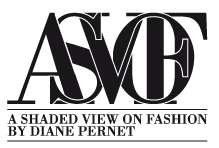Dear Shaded Viewers,
Two weeks ago, during MQ Vienna Fashion Week, Carole Pope and I chased down shy couturier Susanne Bisovsky after her exhilarating catwalk show. We were over the moon when she and her gregarious partner, Joseph Gerger, invited us for a visit to their salon in the newly trendy 7th district. Tucked away westwards beyond the cobblestoned pedestrian zone of Spittelberg (the “village in the city”), Susanne’s salon (and home, as it turns out) inhabits an old silk-fabric factory.
Joseph greeted us on the first floor and took us up in the elevator where, much to our amusement, he pointed out a bit of graffiti that had been inscribed by interior designer and fashion icon Iris Apfel. “She was playfully mimicking the tags left by gypsies,” Joseph explained as he pointed to an example of said markings near Apfel’s. “The gypsies have codes for certain things, such as which apartments are safe to rob.”
The first thing one notices when entering the high-ceilinged rooms where Susanne and Joseph work and live, is the explosion of floral motifs–on upholstery, curtains, clothing, bags and in outsized bouquets of flowers rendered in bright yarn.
Above: Susanne Bisovsky doesn’t like to have her picture taken, but because I am a pushy New Yorker, I talked her into it.
A few things to know about Susanne Bisovsky…
She started out her career in fashion around 1990 when she worked with Jean-Charles de Castelbajac. A few years later, she was collaborating with fellow Austrian Helmut Lang. That’s when she invented the process of creating lace dresses from latex which featured largely in Lang’s collections (1995’s “Dress of the Year”). It should be noted that Helmut Lang started out designing clothes that were traditionally Austrian, back in the 1980s–an aesthetic that has always informed Bisovsky’s designs.
In the early 2000s, Lang wanted Bisovsky to move to New York and continue to work with him there. But the two designers were moving in completely different directions at that point. “I wasn’t interested in New York,” Bisovsky tells us. “Or the whole fashion game.” Instead, she invented the concept of the “everlasting collection”–an evergreen line of clothing that is handmade to suit particular clients’ taste.
Susanne Bisovsky does not advertise and only stages runway shows according to her moods. But clients, mainy Austrian but also others from around the world, know how to find her. They come in, peruse the couture pieces and the treasure-trove of fabrics and trimmings that Bisovsky has collected from around the world. Measurements are taken, choices are made.
Every Friday, Susanne and Joseph hold a couture salon where clients drop by and a model parades a selection of looks. Very 1950s, very intimate. If a client wants a version of a couture piece, Susanne can reproduce it about 80% to the original, depending on the availability of materials. Her vintage fabrics are culled from flea markets and eBay, or spring from the suitcases of globe-trotting friends.
While enchantingly old-school, Susanne’s process (she calls it “slow fashion”) goes beyond a ’50s couture mentality–it’s a new frame of reference with up-to-date technology and a multi-universal mix of cultures and history. At the end of the day, she’s more of a fine artist than a fashion designer.
Susanne’s big book documents her journey through design.
Each photo–such as this Frida Kahlo doppelganger in a Mexican-flavored ensemble–is lovingly bordered with intricate trim.
Susanne and Joseph are obsessive collectors. I love these grained-wood candy & nut dishes.
Carole models one of Susanne’s hats.
Buttons and badges and brooches and bricolage.
Susanne shows off one of her pleated dresses.
This fabric from China was dyed with pig’s blood.
Joseph is a shoe designer and he showed us some of the designs he worked on for Susanne’s collections.
On the chair is a rather magnificent mantilla that one of Susanne and Joseph’s friends brought back from Spain. Susanee thought it too special to cut up and turn into a dress so she is archiving it. Here she is holding up a shawl. I think it’s from Poland? Suzy Menkes wrote about the mantilla in her wonderful piece about Susanne and Vienna fashion which appeared in the New York Times a few months ago.
And now, let’s take a tour of the kitchen…
Have you ever seen so many cookie tins?
Of course many interior magazines have done stories on Susanne and Josph’s home but wouldn’t this have been a perfect feature for the now-defunct NEST?
Oh, so lovely. The one on the upper right features the Karlskirche in Vienna (I visited it on my first trip to Vienna back in 2002). Constructed between 1715 and 1737, it was erected in honor of Karl
Borromeo who was the patron saint that led the fight against the plague
epidemic in 1713.
Even the bathroom is resplendent in floral- and religous-motif tins.
I hope you enjoyed this visit.
Love,

